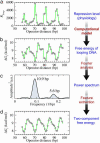Inferring the in vivo looping properties of DNA
- PMID: 16303869
- PMCID: PMC1287912
- DOI: 10.1073/pnas.0505693102
Inferring the in vivo looping properties of DNA
Abstract
The free energy of looping DNA by proteins and protein complexes determines to what extent distal DNA sites can affect each other. We inferred its in vivo value through a combined computational-experimental approach for different lengths of the loop and found that, in addition to the intrinsic periodicity of the DNA double helix, the free energy has an oscillatory component of about half the helical period. Moreover, the oscillations have such an amplitude that the effects of regulatory molecules become strongly dependent on their precise DNA positioning and yet easily tunable by their cooperative interactions. These unexpected results can confer to the physical properties of DNA a more prominent role at shaping the properties of gene regulation than previously thought.
Figures




References
-
- Alberts, B. (2002) Molecular Biology of the Cell (Garland, New York).
-
- Müller-Hill, B. (1996) The lac Operon: A Short History of a Genetic Paradigm (Walter de Gruyter, Berlin).
-
- Schleif, R. (1992) Annu. Rev. Biochem. 61, 199–223. - PubMed
-
- Adhya, S. (1989) Annu. Rev. Genet. 23, 227–250. - PubMed
-
- Vilar, J. M. G. & Saiz, L. (2005) Curr. Opin. Genet. Dev. 15, 136–144. - PubMed
MeSH terms
Substances
LinkOut - more resources
Full Text Sources

